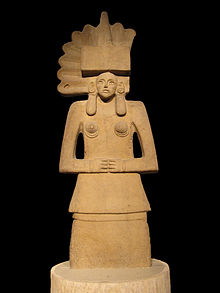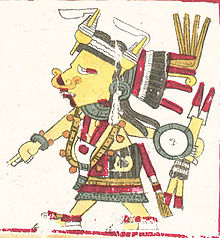User:Benitocpf/Drafting for Tlazōlteōtl
First paragraph[edit]
original[edit]

In Aztec mythology, Tlazolteotl (or Tlaçolteotl, Classical Nahuatl: Tlazōlteōtl, pronounced [tɬaso:ɬˈteo:tɬ]) is a goddess of purification, steam bath, midwives, filth, and a patroness of adulterers. In Nahuatl, the word tlazōlli can refer to vice and diseases. Thus, Tlazōlteōtl was a goddess of filth (sin), vice, and sexual misdeeds. However, she was a purification goddess as well, who forgave sins and cured diseases caused by misdeeds, particularly sexual misdeeds.[1] Her dual nature is seen in her epithets; Tlahēlcuāni ('she who eats tlahēlli or filthy excrescence [sin]') and Tlazōlmiquiztli ('the death caused by lust'), and Ixcuina or Ixcuinan (Huastec: Ix Cuinim, Goddess of Cotton).[2][3][4] Under the designation of Ixcuinan she was thought to be quadripartite, composed of four sisters of different ages known by the names Tiyacapan (the first born), Tēicuih (the younger sister, also Tēiuc), Tlahco (the middle sister, also Tlahcoyēhua) and Xōcotzin (the youngest sister). When conceived of as four individual goddesses, they were called ixcuinammeh or tlazōltēteoh.[3][4]
Tlazōlteōtl presides over the 13th trecena of the sacred 260-day calendar, the one beginning with the day Ce Ōllin, or First Movement. She is associated with the day sign of the jaguar.[5]
New Version[edit]

In Aztec mythology, Tlazolteotl (or Tlaçolteotl, Classical Nahuatl: Tlazōlteōtl, pronounced [tɬaso:ɬˈteo:tɬ]) is a goddess of vice, purification, steam baths, lust, midwives, filth, and a patroness of adulterers. She is known by three names,Tlahēlcuāni ('she who eats tlahēlli or filthy excrescence [sin]') and Tlazōlmiquiztli ('the death caused by lust'), and Ixcuina or Ixcuinan (Huastec: Ix Cuinim, Goddess of Cotton), the latter of which refers to a quadripartite association of four sister goddesses. [6][3][4]
Tlazōlteōtl presides over the 13th trecena of the sacred 260-day calendar, the one beginning with the day Ce Ōllin, or First Movement. She is associated with the day sign of the jaguar.[7]
Tlazolteotl played an important role in the confession of wrongdoing, through her priests.[8]
Aztec Religion[edit]

Tlazolteotl may have originally been a Huaxtec goddess from the Gulf Coast,[1] who would have been assimilated into the Aztec pantheon.
Quadripartite Goddesses[edit]
Under the name of Ixcuinan she was thought to be quadripartite, composed of four sisters of different ages known by the names Tiyacapan (the first born), Tēicuih (the younger sister, also Tēiuc), Tlahco (the middle sister, also Tlahcoyēhua) and Xōcotzin (the youngest sister). When conceived of as four individual goddesses, they were called ixcuinammeh or tlazōltēteoh[3][4]; individually, they were goddesses of luxury.[9]
